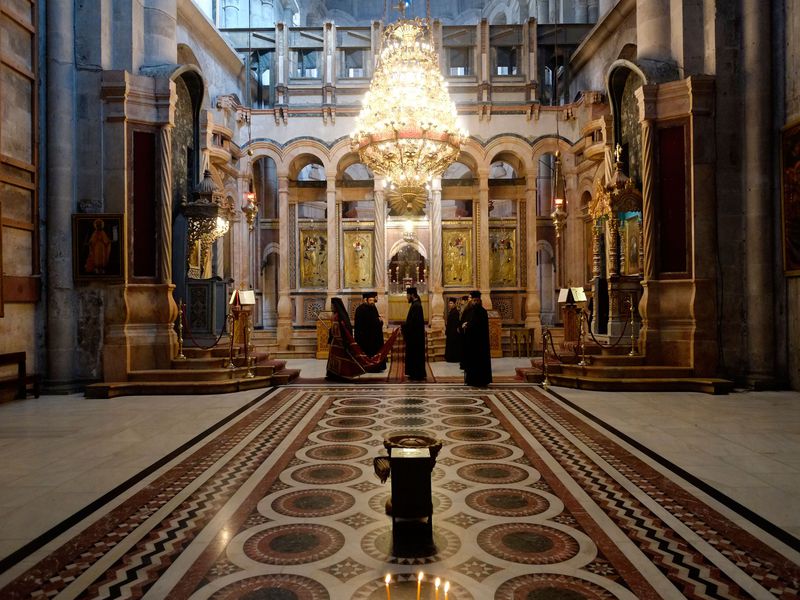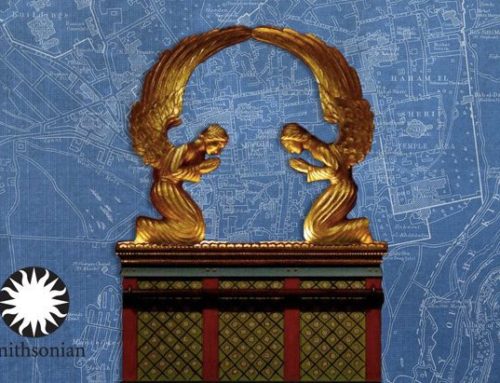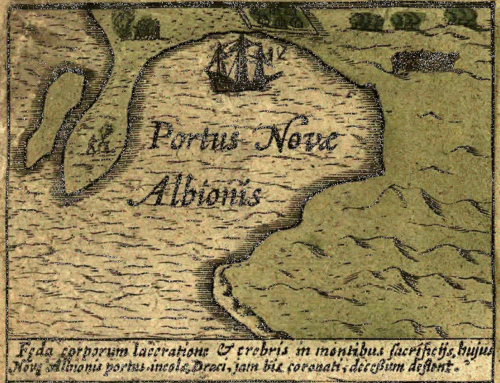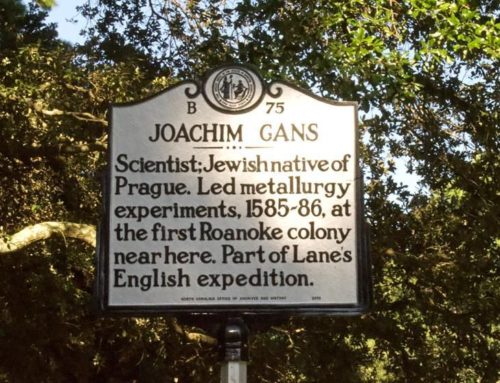
Greek Orthodox priests taking part in a procession inside the Katholikon, or Catholicon Chapel, in the Church of the Holy Sepulcher in Jerusalem. (Eddie Gerald / Alamy Stock Photo)
For decades it was known only as the “graffiti stone.” Leaning against a wall in a shadowy corner of Jerusalem’s Holy Sepulcher, the big blank rock the size of a dining-room table invited scribbling by passing pilgrims and tourists.
But two Israeli researchers who recently examined the other side of the stone say the neglected artifact appears to be part of the high altar fashioned in the early 12th century by medieval Crusaders for the holiest church in Christendom, and upon which Mass was celebrated for more than 500 years. The stone’s intricate design, they add, is based on what was the latest Roman style and suggests a direct link to the papacy itself. The revelation highlights the complicated religious politics that still trouble Jerusalem.
The Crusaders were heeding the call of Pope Urban II, who in 1095 urged Western Christians to assist the Byzantine Empire in recovering territory long ruled by Muslims, including Jerusalem. When the European invaders arrived four years later, they put tens of thousands of the city’s inhabitants, Muslims and Jews alike, to the sword and rushed to the Holy Sepulcher, the shrine to the death and resurrection of Jesus. The victorious knights immediately ejected the Greek Orthodox clergy, whom they suspected of both heresy and complicity with Islamic rulers (the eastern and western churches had split in 1054). They then seized control of the city’s other sites sacred to Jews and Muslims as well as Christians, forbidding those of other faiths from entering Jerusalem.
The Roman Emperor Constantine, who legalized Christianity, approved construction of the Holy Sepulcher in 326 A.D., and ordered “that it should surpass all the churches of the world in the beauty of its walls, columns, and marbles.” He had a Roman temple demolished to make way for a massive 250-foot-long basilica and an open-air colonnade enclosing the traditional site of the Crucifixion. He also had a round building situated just to the west built above a rock-cut tomb from the 1st century A.D., venerated as the place where Jesus rose from the dead.
By the time the Crusaders entered the once-sumptuous complex more than 700 years later, it had already been battered by neglect and earthquakes, and largely destroyed once during a Persian conquest and later at the order of a mad Egyptian king. The newcomers rebuilt the church in the grand Romanesque and early Gothic style, uniting all three areas into one structure that survives to this day. Western European control of Jerusalem lasted only until 1187, when a Muslim army under Saladin reconquered the city. Though Crusader knights gained brief access to Jerusalem in the following century, the invaders were finally driven from the Holy Land in 1291. They left behind enormous castles and a bevy of churches, but their brutal tactics engendered resentment among the region’s Jews, Muslims, and eastern Christians that lingers even now. After the Crusaders left, the Greek Orthodox reclaimed much of the church, including the Aedicule, the small building sheltering the tomb, and the central nave and high altar to the east.
A devastating fire in 1808 gutted much of the church’s interior. The Aedicule was rebuilt, but but the high altar set up by the Crusaders east of the tomb vanished in the subsequent renovation.
A Greek team of engineers and architects recently restored the Aedicule, which had long been in danger of collapse. In the course of the effort, the construction crew used a crane to lift a two-ton block, referred to as the “graffiti stone” after visitors’ penchant for leaving their mark on it, into a steel cradle, turning it around in the process but relegating it to another dark corner.
Amit Re’em of the Israeli Antiquities Authority, who was monitoring the Aedicule work, spotted the newly revealed side of the limestone panel one day and was stunned by the intricate circles carved into the rock with traces of marble and the rich red stone called porphyry. “It is an exquisite piece of art,” he says. “And it was clear to me that the size of the stone and the unique decoration must be something special.”
Re’em, who specializes in medieval archaeology, immediately went to a Jerusalem library to look for evidence of other stones with similar decorations in order to pinpoint its origin. With the help of historian Ilya Berkovich at Munich’s Ludwig Maximillian University, he pieced together the stone’s strange odyssey, and what it might reveal about the Crusader era.
They discovered that Greek archaeologists in 1969 began excavating in the nave and under the main altar east of the Aedicule, areas that remain in the hands of the Greek Orthodox clergy. Though the results were never made public, a curious Catholic priest reported that the team found Crusader-era remains. Some were covered up, but others, including the rectangular panel examined by Re’em, were removed so that the researchers could access material from the earlier Byzantine era.
Re’em and Berkovich tracked the geometric pattern on the stone’s design to a style popular in Rome in the 12th century. The use of four circles surrounding a central circle, all richly inlaid, was the trademark design of the Cosmati family, Roman artisans who worked for the pope. The stone’s design “symbolized the power, both temporal and spiritual, that the Papacy achieved during the 12th century,” writes art historian and New York architect Paloma Pajares-Ayuela in the definitive book on the style. That suggested the stone was carved and inlaid when the Crusaders rebuilt the church.
“I think that this exquisite piece of art could be evidence for the papal artistic patronage in the church,” Re’em says. “It is proof that Crusader art was highly developed” and reflects the direct influence of Rome on the distant Jerusalem shrine. Most of the Crusader knights were French and German, and there are few contemporary reports detailing the 12th-century reconstruction of the church. The stone panel, he added, suggests that papal craftsmen may have been directly involved in the work.
The two researchers then examined the panel to see where it might have been used. Since the bottom portion was unfinished, they determined that it was not flooring, nor was such a design used in the various tombs in and around the church. Instead, it appeared to have been a standing stone framed by other materials. “The best answer is that this was the high altar of the Crusader-era church,” said Re’em. Mass was first celebrated on the altar July 15, 1149, exactly 50 years after the Crusaders conquered the city, and remained the site of Eucharistic offerings until the 1808 fire, when it was buried under the new floor, and only exhumed nearly a half century ago and then propped against a north wall of the church.
One European archaeologist, who requested anonymity because of religious sensitivities, explained that the altar’s disappearance reflects ancient tensions. Greek Orthodox clergy, he explained, are more interested in remains of the original Constantinian church than recovering those of the early 12th century, when the triumphant Crusaders for a brief time banished them as heretics from the complex they had long overseen.
One art historian, who likewise requested anonymity, is unconvinced by Re’em’s analysis, noting that some Byzantine craftsmen used similar designs that influenced Cosmati work in Rome. More research needs to be done to determine with precision the maker and precise placement of the stone. Since part of the panel is broken off, Re’em hopes to find the location of the remaining section.
In the meantime, Greek Orthodox, Roman Catholics, Armenians, Copts, and Syrians jealously guard their respective territories within the Holy Sepulcher, with Ethopians relegated to the roof. Scuffles among clergy of the different sects is not uncommon, and occasional bloodshed is recorded. Two Muslim families hold the keys to the great Crusader doors to ensure everyone access.
The Greek Orthodox spokesman, Metropolitan Isychios of Kapitolias, did not reply to request for comment on the stone panel, and the scaffolding containing the stone remains parked and unmarked against a wall, just a few dozen yards from its original presumed position on the rebuilt high altar. Now, however, its faded but graceful decoration, a likely reminder of Rome’s fateful impact on the medieval Middle East, can once again be seen.




